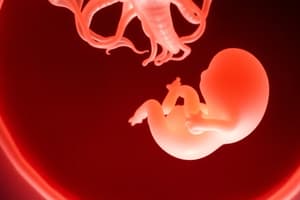Podcast
Questions and Answers
During gastrulation, which germ layer replaces the hypoblast?
During gastrulation, which germ layer replaces the hypoblast?
- Paraxial Mesoderm
- Ectoderm
- Mesoderm
- Endoderm (correct)
Which of the following structures induces neurulation in the overlying ectoderm?
Which of the following structures induces neurulation in the overlying ectoderm?
- Intermediate mesoderm
- Somites
- Neural crest cells
- Notochord (correct)
What is the origin of sensory nerve cells, ganglia, and melanocytes?
What is the origin of sensory nerve cells, ganglia, and melanocytes?
- Lateral mesoderm
- Intermediate mesoderm
- Neural crest cells (correct)
- Somites
Somites are formed from which type of mesoderm?
Somites are formed from which type of mesoderm?
The urogenital system develops from which embryonic structure?
The urogenital system develops from which embryonic structure?
During which week of development does lateral folding occur, leading to the formation of the future gut?
During which week of development does lateral folding occur, leading to the formation of the future gut?
By the end of the second month (8 weeks) of development, what significant event has occurred?
By the end of the second month (8 weeks) of development, what significant event has occurred?
During which period of prenatal development do organs primarily grow in size and complexity?
During which period of prenatal development do organs primarily grow in size and complexity?
In what month of fetal development do ossification centers begin to appear in bones?
In what month of fetal development do ossification centers begin to appear in bones?
During which months of fetal development does the fetus begin to resemble a human, with the formation of fingers, eyes, and ears?
During which months of fetal development does the fetus begin to resemble a human, with the formation of fingers, eyes, and ears?
During which prenatal period do the organs form from the three primary germ layers?
During which prenatal period do the organs form from the three primary germ layers?
What key event characterizes cleavage during the first week of embryonic development?
What key event characterizes cleavage during the first week of embryonic development?
Why is implantation delayed until approximately day 6 after fertilization?
Why is implantation delayed until approximately day 6 after fertilization?
If a fertilized egg implants in the fallopian tube and begins to develop, why is this dangerous?
If a fertilized egg implants in the fallopian tube and begins to develop, why is this dangerous?
What is the primary reason for the maternal body to calcify around a lithopedion (stone baby)?
What is the primary reason for the maternal body to calcify around a lithopedion (stone baby)?
During week 2 of embryonic development, the inner cell mass differentiates into which two layers?
During week 2 of embryonic development, the inner cell mass differentiates into which two layers?
Which of the following is derived from the epiblast?
Which of the following is derived from the epiblast?
What is the primary function of the amniotic fluid?
What is the primary function of the amniotic fluid?
What is the primary role of the yolk sac in human embryonic development?
What is the primary role of the yolk sac in human embryonic development?
Which structure gives rise to the extraembryonic membranes?
Which structure gives rise to the extraembryonic membranes?
Flashcards
Embryology
Embryology
The study of the origin and development of single individuals.
Prenatal period
Prenatal period
The time from conception to birth, including embryonic and fetal periods.
Embryonic period
Embryonic period
First 8 weeks post-fertilization where major organ systems form.
Fetal period
Fetal period
Signup and view all the flashcards
Zygote
Zygote
Signup and view all the flashcards
Blastomeres
Blastomeres
Signup and view all the flashcards
Morula
Morula
Signup and view all the flashcards
Blastocyst
Blastocyst
Signup and view all the flashcards
Bilaminar embryonic disk
Bilaminar embryonic disk
Signup and view all the flashcards
Implantation
Implantation
Signup and view all the flashcards
Primitive streak
Primitive streak
Signup and view all the flashcards
Gastrula
Gastrula
Signup and view all the flashcards
Three germ layers
Three germ layers
Signup and view all the flashcards
Endoderm
Endoderm
Signup and view all the flashcards
Mesoderm
Mesoderm
Signup and view all the flashcards
Ectoderm
Ectoderm
Signup and view all the flashcards
Notochord
Notochord
Signup and view all the flashcards
Neurulation
Neurulation
Signup and view all the flashcards
Somites
Somites
Signup and view all the flashcards
Study Notes
Prenatal Development
- Embryology studies the origin and development of individuals
- Prenatal period encompasses the embryonic and fetal periods
- Embryonic period: first 8 weeks after fertilization (in utero)
- Fetal period: remaining ~30 weeks after fertilization (in utero)
- No direct connection exists between the oviduct and ovary
- Fertilization: sperm meets and fuses with the egg (oocyte)
- Zygote: the fertilized egg (single cell)
- Early development includes: 4-cell stage, morula, blastocyst, implanting blastocyst
Embryonic Period (First 8 Weeks)
- Major events:
- Organs form from three primary germ layers
- Basic body plan emerges
- Conception: occurs in the lateral third of the uterine tube
- Zygote: fertilized oocyte (one cell)
- Moves towards the uterus via cleavage (cell division without growth)
- Blastomeres: daughter cells produced from zygote
- Morula: a cluster of 12-16 blastomeres
- Blastocyst: fluid-filled structure containing approximately 60 cells.
- Trophoblast: outer layer of cells (becomes extraembryonic membranes)
- Inner cell mass: inner clump of cells (becomes the developing organism)
- Implantation: into the endometrium of the uterus occurs on day 6
Week 1 Events
- Zygote formation, cleavage to blastomeres, morula to blastocyst.
- No growth during cleavage, blastocyst growth to implantation
- Blastocyst implants in uterine lining by day 7
- Implantation occurs in uterine wall day 6
- Ectopic pregnancy: fertilized egg implanting outside the uterine wall (dangerous)
- Stone baby: rare viable ectopic pregnancy (developed to 32 weeks)
Week 2 Events
- Blastocyst forms bilaminar embryonic disk
- Epiblast (top layer)
- Hypoblast (bottom layer)
- Amniotic sac: formed from an outgrowth of the epiblast
- Yolk sac: formed from the hypoblast
- Yolk sac is crucial in other animals but placenta mammals do not need it
Week 3 Events
-
Primitive streak: migration of epiblast cells, forms gastrula.
-
Gastrulation: cells migrate inward forming three layers: ectoderm, mesoderm, and endoderm
-
Notochord (from mesoderm)
- Forms the basis of the vertebral column, important signaling structure
-
Neurulation: ectoderm forms the neural tube (future brain and spinal cord)
- Neural plate: thickened ectoderm
- Neural folds: inward movement creates a groove
- Neural tube: hollow tube
-
Somites (paraxial mesoderm): form body segments; vertebrae, ribs, muscles.
-
Intermediate mesoderm: forms urogenital system
Week 4 Events
- Lateral folding: forms the gut tube
- Yolk sac pinched off
Major Layers of the Embryo
- Ectoderm: epidermis, hair, nails, glands of skin; brain, spinal cord, nervous system.
- Mesoderm: nucleus pulposus, kidneys, gonads, skeleton, muscles, circulatory system
- Endoderm: lining of digestive and respiratory tracts
Week 5 Events
- Head accounts for 50% of body length
- Limbs form as rudimentary appendages
- Placenta fully functional
Fetal Period
-
Starts at week 9 post-fertilization until birth
-
Organs grow in size and complexity
-
3rd month: head growth slows and body increases in length
-
Bone ossification begins
-
Sex can be determined by the end of the third month
-
5th to 7th months: Human-like features appear
-
8th and 9th month: Fetal preparation for birth
-
Mother’s perception of fetal movement: begins in the 3rd or 4th month.
-
Fetal viability: 22-24 weeks, lungs developed, ability to survive outside the womb.
Studying That Suits You
Use AI to generate personalized quizzes and flashcards to suit your learning preferences.




